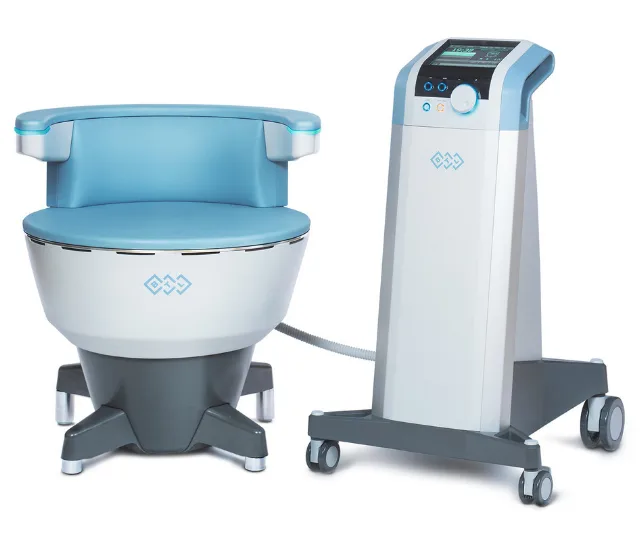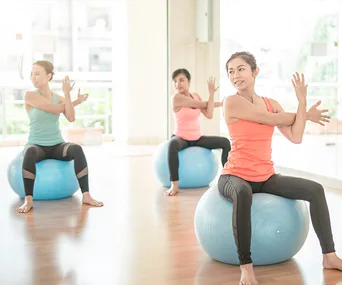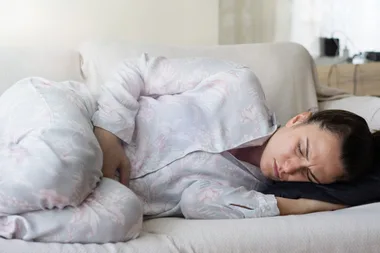One in two women will suffer some level of pelvic floor dysfunction following childbirth. Whether we’re too scared to sneeze, or not enjoying sex as much as we should be, issues with the pelvic floor can cause discomfort in our lives, and until now, have taken a lot of work to try and overcome.
Traditionally those seeking help for pelvic floor issues were encouraged to try regular, gentle exercises which, unless women were prepared to go down the surgical route, was the only option, other than simply living with the symptoms.
New techniques such as the minimally invasive, non-surgical laser procedures for treating and improving vaginal health have offered some success recently, however there’s a new kid on the block and it is even less invasive.

The Emsella Chair is revolutionising women’s pelvic health. Image: Supplied.
The Emsella Chair, which patients simply sit in – fully clothed – for six 28 minute sessions, uses advanced electromagnetic energy to engage all the muscles of the pelvis and produce thousands of pelvic floor muscle contractions simultaneously. The action is similar to Kegel exercises, however, with far more intensity, a single session is equivalent to the intensity of 11,200 pelvic floor exercises.
Its aim is to restore neuromuscular control in the pelvic region, particularly pelvic floor muscles and the bladder, and according to those who have tried it, it works.
“It will drastically improve the quality of life for many women who have otherwise learnt to live with their symptoms,” says fertility specialist, Dr Sonya Jessup of Elsa Clinic in Sydney
“This device is proving that just because you’ve had a child it doesn’t mean you shouldn’t have a great and functional body.”

Dr Sonya Jessup is a female Fertility Specialist and Gynaecologist based in South and Western Sydney. Image: Supplied.
53-year-old Le-Arne from Sydney’s south has completed six sessions in the chair and says it has completely changed her life.
“I couldn’t even go to the shopping centre without having to search for a bathroom 20 minutes in,” says Le-Arne. “It was not uncommon for me to have to leave my groceries in the middle of the aisle and hope they were still there when I came back.”
Le-Arne’s sleep was also impacted by the need to wake several times through the night to go to the bathroom.
“For me surgery was not an option, because I’m terrified of going under anaesthetic,” explains Le-Arne. “But I tried all the exercises and even had botox in the area to try and get some relief, but nothing had worked and I was resigned to just living with the discomfort and inconvenience.”
WATCH: Pilates exercises for pelvic floor muscles. Continues after video …
For Le-Arne the difference was noticeable after just three sessions in the chair.
“It was my fourth appointment, and I walked in and it was the receptionist, who was so used to me walking in and heading straight for the bathroom, who pointed out that I didn’t do it this time. That’s when I realised that I felt different,” she laughed. “I always head straight for the bathroom everywhere I go, and I really didn’t have that feeling.”
As for the treatment itself, Le-Arne can’t stress enough how simple and non-invasive it is.
“You really do just sit in a chair,” se says. “You can feel the contractions happening, but it’s not painful at all. I would take the half hour for myself to read a magazine or paint my nails.
“It’s incredible to think that something so easy had had such a huge impact on something that has been a problem in my life for sixteen years.”
And the complete relief from the bladder issues was not the only benefit that Le-Arne has found after her sessions in the chair.
“My husband has pointed out that things feel a lot like they did before I had my pregnancies,” Le-Arne laughs. “It’s been a complete game-changer for our sex-life too.”

Le-Arne has found life-changing results after six sessions in the chair. Image: Supplied.
Dr Jessup believes the device will become a game-changer for women’s health, with technology that will change the way doctors treat incontinence and vaginal laxity.
“Simply put, we’ve not had anything like this available to patients in Australia before.”
The machine works by sending electromagnetic pulses through the area, forcing it to contract 11,000 times in the 28 minutes sessions.
“Each contraction is much harder than one done voluntarily by patient, which is why they are so effective,” explains Dr Jessup.
The sessions are done with a week or two break in between, meaning that in a very short amount of time, patients will find relief. And the good news for mum is you don’t need to be done having children to benefit.
“Because it’s non-invasive you can do it in between pregnancies with no ill-effects,” says Dr Jessup.
Do it,” says Le-Aren. “You don’t have to live with problems with your pelvic floor when it can be fixed so easily.”
.png?fit=900%2C751)


